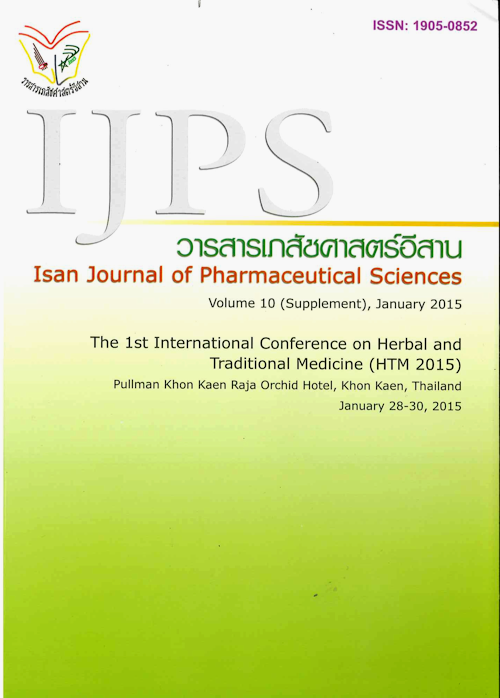Mechanisms of Molluscicidal Activity of Citrus hystrix against Pomacea canaliculata
Main Article Content
Abstract
Pomacea canaliculata (Golden apple snail) is an invasive pest that seriously affects rice cultivation. It causes one of serious agriculture problems in many Asian countries. To control these snail populations, synthetic chemical molluscicides were mainly used. However, these molluscicides may cause long-term disadvantage to the environment and also impact on ecological system. Finding natural substances that kill golden apple snails, therefore, is an alternative way to decrease number of snails and their epidemic. The molluscicidal activity of peels and pulps Cirus hystrix (C. hystrix) extracts on Pomacea canaliculata were evaluated under controlled laboratory conditions. C. hystrix peel methanol extract was toxic to the snail with LC50 71.66 mg/L. Conversely, no snail was found dead in C. hystrix pulp methanol extract. The molluscicidal mechanism of C. hystrix peel methanol extract on P. canaliculata was also evaluated through change of selected biochemical parameters, including acetylcholinesterase activity, glycogen and protein contents. There was no signifi cantly change in any biochemical parameters. These results suggest that methanol extracts from peels of C. hystrix had molluscicidal activity which could be utilized as bioherbicide for future weed control. However, the mechanisms of molluscicidal activity were still unclear.
Article Details
In the case that some parts are used by others The author must Confirm that obtaining permission to use some of the original authors. And must attach evidence That the permission has been included
References
Benavente-Garcia o, Castillo J, Marin FR, et al. Uses and properties of citrus flavonoids. J Agri Food Chem 1997; 45: 4505-4515.
Chinapongtitiwat V, Jongaroontaprangsee S, Chiewchan N, et al. Important flavonoids and limonin in selected Thai citrus residues. J Funct Foods 2013; 5: 1151-1158.
Chowdhurry A, Alam MA, Rahman MS, et al. Antimicrobial, antioxidant and cytotoxic activities of Citrus hystrix DC. fruits. J Pharm Sci 2009; 8(2): 177-180
Dai L, Wang W, Dong X, et al. Molluscicidal activ-ity of cardiac glycosides from Nerium indicum against Pomacea canaliculataand its implications for the mechanisms of toxicity. Environ Toxicol Pharmacol2011; 32: 226-232
Ellman LG, Courtney KD, Andres V Jr, et al. A new rapid colorimetric determination of acetylcholinesterase activity. Biochem Pharmacol 1961; 7: 88-95.
Hafeez F, Akram W, Shaalan Abdel-Salam E. Mosquito larvicidal activity of citrus limonoids against Aedes albopictus. Parasito Res 2011; 109(1): 221-229.
Halwart M. The golden apple snail Pamacea canaliculata in Asian rice farming system: present impact and future threat. Int J Pest Manage 1994; 40(2): 199-206.
Jayaprakasha GK, Singh RP, Pereira J, et al. Limonoids from Citrus reticulata and their moult inhibiting activity in mosquito Culex quinquefasciatus larvae. Phytochemistry1997; 44(5): 843-846.
Joshi RC, Meepagala KM, Sturtz G, et al. Molluscicidal activity of vulgarone B from Artemisia douglasiana Besser to the invasive, alien mollusk pest, Pomacea canaliculata (Lamarck). Int J Pest Manage 2005; 51(3): 175-180.
Joshi RC, San Martin R, Saez-Navarreteb C, et al. Efficacy of quinoa (Chenopodium quinoa) saponin against golden apple snail (Pomacea canaliculata) in the Philippines under laboratory conditions. Crop Prot 2008; 27: 553-557.
Li X, Deng F, Shan X, et al. Effects of the molluscicidal agent GA-C13:0, a natural occurring ginkgolic acid, on snail mitochondria. Pest Biochem Physiol2012; 103(2): 115-120.
Loh SF, Awang MR, Omar D, et al. Insecticidal properties of Citrus hystrix DC leaves essential oil against Spodoptera litura fabricius. J Med Plant Res 2011; 5(16): 3739-3744.
Manners GD. Citrus limonoids: Analysis, bioavail-ability and biomedical prospects. J Agri Food Chem 2007; 55: 8285-8294.
Naylor R. Invasions in agriculture: assessing the cost of the golden apple snail in Asia. Ambio 1996; 25(7): 443-448.
Ohta H, Hasegawa S. Limonoids in pummelos (Citrus grandis (L.) Osbeck). J Food Sci1995; 60: 1284-1285.
Ram L, Singh S. Medicinal importance of citrus products and by-product-a review. Agri Rev 2006; 27: 170-180.
Roy A, Sara S. Limonoids: Overview of signifi cant bioactive triterpenes distributed in plant kingdom. Biol Pharmaceut Bull 2006; 29: 191-121.
Saravanan M, Kumar DV, Malarvizhi A, et al. Biosafety of Azadirachta indica (A. Juss) leaves extracts on certain biochemical parameters of Labeo rohita. J Biopest2010; 3: 227-231.
Suryavanshi U, Sreepada RA, Ansari ZA, et al. A study on biochemical change in the penaeid shrimp, Metapenaeus monoceros (Fabricius) following exposure to sublethal doses of organochlorine pesticide (endosulfan). Chemosphere 2009; 77: 1540-1550.
Sin TS. Damage potential of the golden apple snail Pomacea canaliculata (Lamarck) in irrigated rice and its control by cultural approaches. Int J Pest Manage 2003; 49: 49-55.
Sun C, Chen K, Chen K, et al. Contents and antioxidant capacity of limonin and nomilin in different tissues of citrus fruit of four cultivars during fruit growth and maturation. Food Chem 2005; 95: 599-605.
Tawtsin A, Wratten SD, Scott R, et al. Repellency of volatile oils from plants against three mosquito vectors. Engl J Med 2001; 26: 76-82.
Upadhyay A, Singh KD. Inhibition kinetics of certain enzymes in the nervous tissue of vector snail Lymnaea acuminate by active molluscicidal components of Sapindus mukorossi and Terminalia chebula. Chemosphere 2011; 85(6): 1095-1100
Van Der Vies J. Two methods of determination of glycogen in liver. Biochem J 1954; 57: 410-416.
WHO. Bulletin of the World Health Organization-33; 1965. 567-581.

